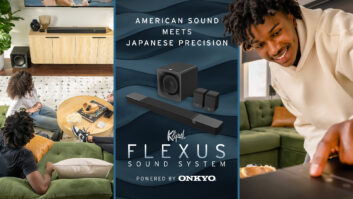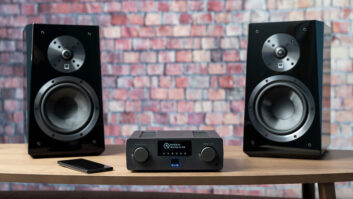The audio business is littered with the remnants of gadgets designed to somehow improve the quality of sound without affecting the quality of the experience. More often than not, these products relied on a powered system that ultimately corrupted the audio signal, with the end result being audio that was louder, not better.
With True Dimensional Sound (TDS), first introduced in a $400 audiophile-grade product in the mid-90s, the potential for improved audio suddenly became a reality, though it took several years for the market to see a product that is well within the reach of most consumers’ budgets.
The Acoustic Research (AR) Sound Enhancer (TDS202) employs TDS sound enhancement technology. The patented TDS technology provides the “feeling” of improved detail, resolution, proximity and immersion that is often lacking in audio presentation of recorded music.
“During my first brush with the product a few years ago, frankly my initial reaction was that it was just another wonderful black box that would end up in my closet, sold or given away,” remembered Max Weinbrenner, senior product manager for the Acoustic Research Division of Recoton, the company that now sells the product. “A year after that the TDS people approached us again and actually had some ideas about how to take their technology to a less expensive level.”
TDS had come back and presented a $400 audiophile box with a less expensive circuit in it. That was when Weinbrenner and others in the company fell in love with it and said, “Okay, this is something we can do something with, but not at $400.”
“I would spend $400 on it, but for what it will do for any system from a $500 system on up, those people are not going to spend $400 for a box,” Weinbrenner explained.
The next step was to have TDS come up with something that sounded as good or better than the audiophile device, but that cost less money. The answer came with decision to have the product’s transformer manufactured in Asia, where the manufacturing process is streamlined. TDS technology was created to compensate for deficiencies (i.e., sensitivity disparity) in the human hearing system. As a result of properly compensating for these deficiencies, TDS enhances the listener’s ability to more accurately hear and perceive the entire presented musical range at any listening level. It enables the listener to discern an increased sound stage, separation, low level and ambient information, restoring the impact and fidelity of a “live performance” that would otherwise not be apparent without TDS. The TDS enhancement is based on the physiological science of human hearing and carefully nurtured by empirical research.
There are several interesting characteristics to discuss in this regard. The first observable characteristic is known as the Fletcher-Munson phenomenon. In this well-documented characteristic of the human hearing system, loudness and pitch are inter-related. The human hearing system is most sensitive to frequencies near the low kilohertz area depending somewhat on the mean intensity of the audio signal. This frequency-dependent sensitivity tends to prohibit (or mask) details in the high-frequency region from being appreciated by the listener. According to Recoton, TDS compensates for this phenomenon by empirically shaping the audio presentation in an appropriately compensating manner. As a listener comes closer to a sound stage, he/she hears a more complete spectral content because of the Fletcher Munson phenomenon.
Weinbrenner explained how he demonstrates the TDS capabilities by playing Dire Straits’ Brothers in Arms album in demos. “In the song, ‘Man Across the River,’ there’s a trumpet solo that was recorded to sound like it was across the river…a distance away from you…and Mark Knopfler is pretty much centered in the recording,” he said. “In some systems everything is one-dimensional. Everything is coming from the wall and nothing is different. In a good system you can get some of that staging, but once you put TDS in there, then all of sudden he’s center and that horn is definitely placed to your right and behind you. That’s the first thing that most people notice. It’s not surround sound, but all of sudden I’ve got depth to my sound. Something that I didn’t have before.”
In a second characteristic, the human hearing system exhibits a characteristic known as temporal masking. This occurs when less dominant sounds are excessively close to more dominant sounds and therefore become masked. This is especially true of short duration, high-frequency sounds that suffer both frequency masking and temporal masking. TDS is designed to extend the duration (longer-is-louder) of short or staccato pulses so that masking effects are limited.
TDS covers the full range of human hearing (20 Hz to 20 kHz). In addition, the technology extends the duration of short-duration pulses so that the net effect is that the short (often-masked) pulses overcome the temporal natural suppression phenomenon and are perceived and appreciated by listeners. The combination of wide-bandwidth-audio processing and long duration impulse response processing preserves rapid rise-time that permits musical attacks to be properly represented.
As a result of the compensation for the basic Fletcher-Munson phenomenon and the coordinated frequency and temporal unmasking, much more appreciation of the richness and detail of a musical presentation are afforded to the listener. Especially significant is that the sound stage appears to be closer to the listener and actually envelops the listener. These significant audio improvements are natural results of TDS compensating for deficiencies (or characteristics) of the human hearing system.
Though first introduced in 1995 to the movie industry for improving soundtracks of feature films, TDS is now employed in the Acoustics Research (AR) Sound Enhancer (TDS202) consumer electronics product, which debuted in the Spring of 2002.
“There were sound engineers and foley artists and all of these people on the commercial side who said that this thing really makes a difference in what they were recording and hearing,” Weinbrenner said. “That’s when they really decided to go into the consumer side.” The AR Sound Enhancer is a passive device designed primarily for two-channel applications. In some receivers, the AR is also compatible in multi-channel matrixes (AC-3, etc.) if more than one AR product is applied. Because the TDS technology works naturally with the human hearing system, the AR Sound Enhancer is compatible with all sound-effect technologies including SRS, Q Sound and Spatializer. The AR Sound Enhancer installs as the midpoint between the audio outputs of a two-channel source and the device inputs on a receiver, amplifier, or pre-amplifier.
Though small in stature (5 1/8-inches [D] x 7 7/8-inches [W] x 2 3/16-inches [H]), AR’s Sound Enhancer can work in almost any music system, from inexpensive stereo systems to high-end audiophile systems featuring state-of-the-art DVD and CD players. But according to Weinbrenner, the key to selling the product is a proper demo, whether it is from a custom installation professional looking to gain just a little bit more performance from a middle to high-end system or a retailer seeking a “wow factor” sale for a walk-in customer. “It really does need to have the ability to be demo’d in a sound room or a showroom,” he said. “That’s the main reason we kept an on/off switch on the front. That way, a salesperson can demonstrate the technology more effectively.”
Weinbrenner realizes that there could be a stigma attached to selling a $99 black box to a client spending more than $10,000 on a top-of-the-line audio system. His answer is to equate the sale to buying better interconnects and cables for the system. “Yes, I’m installing the best system, but this little device will make it even better,” he said.
So how does this product fit in with AR’s other product lines? “The AR accessories that I live as with product manager kind of run the gambit from speaker selectors to good, better, best options in the interconnect world,” Weinbrenner explained. “The whole idea was to create products that would improve listening and viewing at a value, and that’s really what we came up with TDS, too. It not only improves audio, but it’s at a really good price for what it does.” For the next generation, AR hopes to adapt the product to improve systems that utilize downloaded MP3 files as content. “It would be for people who might have an inexpensive audio system but an expensive computer where they listen to everything. There are a lot of little adaptations. It will help bring back all of those things that are compressed and removed from the music.”
Jeremy J. Glowacki is editor of Residential Systems.







